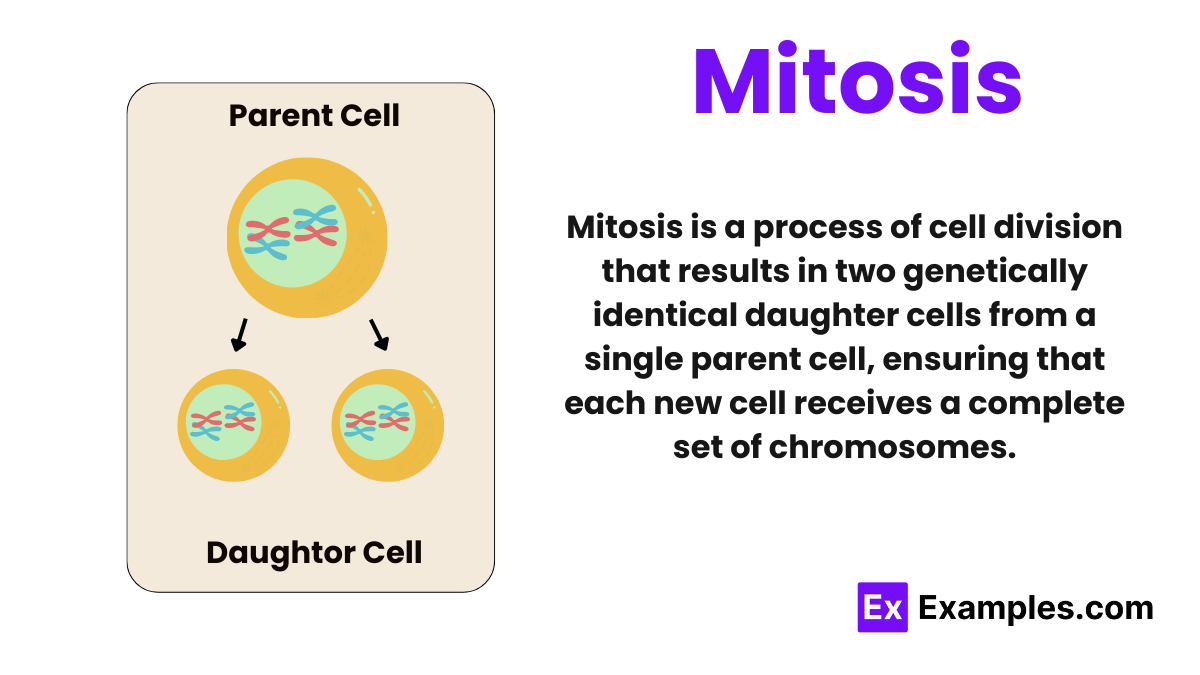During which phase of mitosis do the chromosomes align in the middle of the cell?
Prophase
Metaphase
Anaphase
Telophase


Mitosis, a fundamental process of cellular division, ensures the continuation of life by enabling growth, repair, and reproduction in multicellular organisms. This complete guide unfolds the intricate stages of mitosis, from prophase to cytokinesis, illustrating how cells duplicate their DNA to create two identical daughter cells. Through practical examples, readers will grasp the significance of mitosis in daily life, from healing wounds to the development of organisms. Dive into the captivating world of cell biology, where mitosis plays a pivotal role in sustaining life’s complexity and diversity.
Mitosis is a process of cell division that results in two genetically identical daughter cells from a single parent cell, ensuring that each new cell receives a complete set of chromosomes. This process is crucial for growth, repair, and reproduction in multicellular organisms. Mitosis is divided into several phases. Cell division is the driving process of reproduction at the cellular level. Most eukaryotic cells divide in a manner where the ploidy or the number of chromosomes remains the same, except in the case of germ cells where the number of chromosomes is halved.
Mitosis is a fundamental process of cellular reproduction, ensuring that when a cell divides, each new cell receives an identical set of chromosomes. Here are its key features:
Mitosis is divided into several distinct stages, each characterized by specific processes that ensure accurate replication and segregation of chromosomes into daughter cells:
Mitosis is termed “equational division” because it equally divides chromosomes, ensuring daughter cells receive identical genetic material as the parent cell.
Mitosis occurs in somatic (body) cells, involved in growth, repair, and maintenance of multicellular organisms.
The primary function of mitosis is to enable growth and repair by producing two genetically identical daughter cells from a single parent cell.
Mitosis is a fundamental process for life, enabling growth, repair, and regeneration by producing identical daughter cells. It maintains genetic consistency across generations of cells, ensuring that each new cell receives a complete set of chromosomes. Understanding mitosis is crucial for grasping cellular function and the basis of genetic diseases, highlighting its significance in biology and medicine.
Text prompt
Add Tone
10 Examples of Public speaking
20 Examples of Gas lighting
During which phase of mitosis do the chromosomes align in the middle of the cell?
Prophase
Metaphase
Anaphase
Telophase
Which structure is responsible for separating the sister chromatids during mitosis?
Nucleolus
Centrioles
Spindle fibers
Golgi apparatus
What happens during anaphase?
Chromosomes condense and become visible.
Chromosomes align at the cell's equator.
Sister chromatids are pulled apart to opposite poles.
The nuclear envelope reforms.
Which phase directly follows prophase in mitosis?
Metaphase
Anaphase
Telophase
Interphase
During which phase does the nuclear envelope break down?
Prophase
Metaphase
Anaphase
Telophase
What is the role of centrioles in mitosis?
To condense chromosomes
To form the spindle apparatus
To replicate DNA
To synthesize proteins
Which phase of mitosis is characterized by the reformation of the nuclear envelope?
Prophase
Metaphase
Anaphase
Telophase
What occurs during cytokinesis?
Chromosomes condense.
Cytoplasm divides to form two daughter cells.
Nuclear envelope dissolves.
Spindle fibers form.
How many daughter cells are produced from a single mitotic division?
One
Two
Three
Four
In which phase of mitosis do chromatids become individual chromosomes?
Prophase
Metaphase
Anaphase
Telophase
Before you leave, take our quick quiz to enhance your learning!

